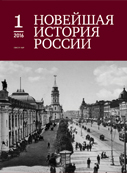Soviet Prisoners of War in Norway 1941–1945 — Destiny, Treatment and forgotten Memories
Soviet Prisoners of War in Norway 1941–1945 — Destiny, Treatment and forgotten Memories
Author(s): M. N. SoleimSubject(s): History, Recent History (1900 till today), WW II and following years (1940 - 1949)
Published by: Издательство Исторического факультета СПбГУ
Keywords: Soviet POW; Norway; 1941–1945; memorials; Soviet soldiers; Soviet-Norwegian relations
Summary/Abstract: The article examines the history of the Soviet POWs, who were transported to the German concentration camps in Norway in 1941–1945. The author points to about 100 000 people, sent by the German authorities in the Norwegian camps, of which about 90 000 were prisoners of war, and the rest - the civilian population, which had been taken out by the Nazis from occupied Soviet territories. Soviet prisoners of war were forced to work in the construction of various facilities, including the railway in northern Norway and highway infrastructure. There were four main camps (Stalags), each of them provided labor force to the building projects in various regions. All works were supervised by German military construction organization Todt. The author emphasizes that Soviet prisoners of war were kept in appalling conditions: they suffered from cold in the harsh climate of Norway, from hunger, poor sanitation, medical care’s lack. It was impossible to fix POWs up after hard work because of short commons. What is more, specific ill-treatment of Soviet prisoners of war was justified by the racist ideology of German Nazism. Soviet POWs were punished ruthlessly for attempts to escape as well for the slightest resistance and disobedience. The Geneva Convention of 1929 was no help to Soviet POWs, since Soviet Union had never ratified it. Such factors as prisoner’s ethnicity, nationality of the guards at the prison camps and the guard’s attitude towards prisoners, and whether they belonged to the Vlasov’s liberation Army or not, became very important for Soviet prisoners’ living conditions in the camps and the treatment. Norwegian people displayed sympathy and care for the abused prisoners. Many people gave them food and clothing, encouraged them with smiles and showed that they were friendly. Locals also assisted prisoners during theirs escape, at great risk to their own lives. Author focused on the problem of preservation of historical memory and described the place which memory about Soviet POWs taken in the social memory of the Norwegian people, how the attitude of society and the state to these pages of the mutual history changed. Government policy is often determined by foreign factors, especially in the era of the Cold War, while the citizens, especially in the northern provinces, have kept the memory of Soviet prisoners of war. The situation changed in the 1990s. The increased interest in the topic of scholars and public has given rise to projects for the creation of a unified database of Soviet prisoners of war in Norway and international cooperation in this field.
Journal: Новейшая история России
- Issue Year: 6/2016
- Issue No: 15
- Page Range: 22-32
- Page Count: 11
- Language: English

